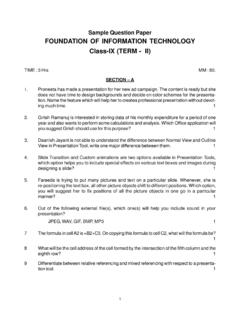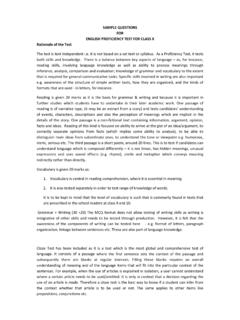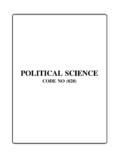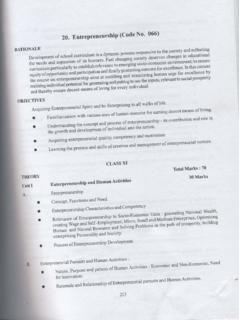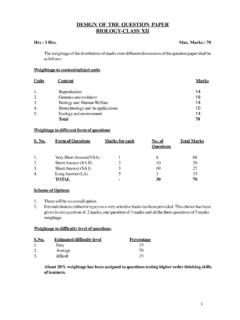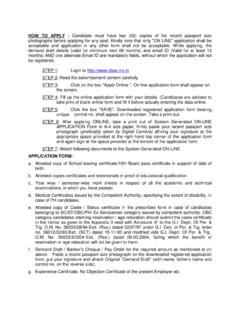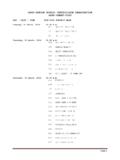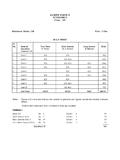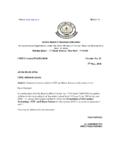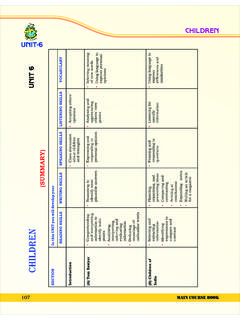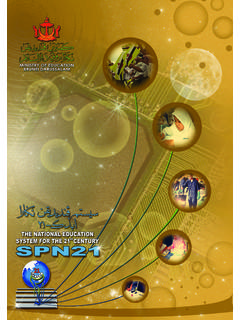Transcription of Magnetic Effect of Current Chapter 13 - CBSE
1 formative assessment Manual for Teachers Magnetic Effect of Current - Chapter 13. Magnetic Effect of Current Chapter 13. assessment Technique: Diagram based worksheet Objectives: To enable the student to Learn the statement of Fleming's right hand rule for finding the direction of the induced Current . Get familiar with this rule for finding the direction of induced emf in a given situation. Clearly differentiate between the physical situations in which this rule and the situations, in which Fleming's left hand rule, are to be used. assessment Time: 20 minutes assessment Task: Individual Worksheet (Figure on page 235 of NCERT Textbook may be drawn on the worksheet). Procedure: The teacher may Discuss the statement of Fleming's right hand rule. Describe the easy way' to remember this rule.
2 Illustrate the use of this rule is some simple situations. Emphasize the difference between the physical situations, in which this rule and the situations, in which Fleming's left hand rule are to be used. Ask the students to use this rule for finding the direction of the induced emf/ Current in some given situations. Help the students to realize that when any two of the three (mutually perpendicular). directions are given we can use this rule for finding the third unknown direction. (a) direction of movement of the conductor (b) direction of Magnetic field (c) direction of induced Current /emf assessment Parameter: One mark for each correct answer. Student Worksheet Instructions: Answer the questions given below: 1. A rectangular coil, ABCD is lying in the plane of the page as shown.
3 A bar magnet, with its north pole pointing towards the page, is moved along a direction perpendicular to the plane of the page. What is the direction of the induced Current in the coil? 151. Chapter 13 - Magnetic Effect of Current formative assessment Manual for Teachers 2. A bar magnet, held with its north and south poles along the east, west direction/. respectively (in the plane of the page) is rapidly moved towards a circular coil held with its plane perpendicular to the plane of the page. What can we say about the direction of the induced Current in the circular coil? 3. For the set up shown here what can we say about the relative directions of deflection of the galvanometer needle when the key is (a) just plugged in (b) taken out after having been kept plugged is for some time?
4 (Draw Fig. in NCERT Text Book page 235). 4. What can we say about the direction of the Magnetic field for the situation corresponding to the right hand' shown here? (Draw Fig. in NCERT Text Book page 235). 5. What can we say about the direction of movement of the conductor, corresponding to the right hand' shown here? (Draw Fig. in NCERT Text Book page 235). Suggested Remediation: Some students may fail to apply Flemings' rules correctly and may mix-up the right hand and the left hand rules. The teacher may help the student to. Clearly identify the difference between the physical situations in which the right hand rule' and the situations in which the left hand rule,' are to be used. Get practice in using Fleming's rules. Know the 'easy way' of remembering Fleming's rules.
5 152. formative assessment Manual for Teachers Source of Energy - Chapter 14. Source of Energy Chapter 14. assessment Technique : Seminar Objectives: To enable the students to Learn some topics by self-study and collaboration Understand how to collect and present data Develop confidence to present a topic before an audience Realize the need to adopt non-conventional and renewable sources of energy Explain how to assess the practical adaptability of a particular source of energy. Task : Group Work Approximate Time : 3-4 days for preparation and 10 minutes for presentation by each group Procedure: A Seminar can be conducted in the class to cover a Chapter . The Chapter to be taught can be divided into different sections. The class will be divided into groups of students.
6 Each group will be allotted a topic and each student, within a group, will be assigned a subtopic. For example: The Chapter Sources of Energy' will be divided into 8 topics including introduction and recapitulation. The students will be advised to put special emphasis on the environmental consequences of using a particular source of energy and on its sustainablity how long will it last. The teacher may divide a class of 40 students into 8 groups. Each group will be allotted a topic as under: Group Topic A Assessing a good source of energy B Conventional sources of energy: Fossil Fuels C Conventional sources of energy: Thermal Power Plants and Hydro Power Plants D Using conventional sources of energy more effectively- Biomass E Using conventional sources of energy more effectively- Wind Energy F Non-conventional Sources of Energy - Solar Energy G Non-conventional Sources of Energy - Energy from Sea (Tidal energy, wave energy and ocean thermal energy).
7 H Non-conventional Sources of Energy - Geothermal and Nuclear energy 153. Chapter 14 - Source of Energy formative assessment Manual for Teachers The teacher will divide each topic into 4-8 subtopics depending upon its complexity and each subtopic will be assigned to a student of every group. The student, in the group, may get any other specific task to be performed in preparing the presentation. Necessary guidance will be given to every group for making the presentations. The areas of assessment would be shared with the students beforehand. The teacher could choose a coordinator from each group who would facilitate the working in each group, ensuring that there is contribution from each participant. A. maximum of 10 minutes may be given to every group to make a presentation.
8 The whole class can participate in this seminar. Student Activity: Study the topic allotted to you. Prepare the topic by using charts / diagrams / blackboard or make a power point presentation (if facilities are available). After the presentation, the student presenter will have to answer two questions put to him by the audience. Time Allotted: 4-5 periods, 3 hours to 4 hours (including assessment by the teacher). Criteria for assessment : The criteria for assessment will be shared with the students before the seminar begins. The students can be assessed on the basis of the format given below: S. Name of the Group Individual Viva Presentation Content and relevance Total N. Student Performance *1 **2 to the topic **2 (5). 1. A. 2. B. 3. C. 4. D. 5. E. Remarks if any * Response to Teacher's Question= mark Response to audience question= mark ** Innovative Introduction = mark Clarity and articulation or delivery mark Use of Visuals = 1 mark ** Comprehension of concept = mark Integration of different points into a proper sequence (Holistic Approach) = 1 mark Conclusion= 1 mark 154.
9 formative assessment Manual for Teachers Source of Energy - Chapter 14. Suggested Remediation: A few students may not perform well during the presentation. The teacher should identify the reason and guide the students accordingly. The students may also be given an alternate activity (Questionnaire based on the presentation made by other groups). Source of Energy Chapter 14. assessment Technique : Individual Worksheet Objectives: To enable the students to Recognize various available sources of energy. Understand the criteria that should be followed to select the right source of energy. Learn the various terms related to use of energy by man Task : Individual Work Approximate Time : 15 Minutes Procedure: The students are given a worksheet that has a crossword puzzle and clues to complete the crossword.
10 The students shall read the given clues carefully and fill up the blocks with appropriate word/term. Student Worksheet Time : 15 minutes Instruction: Read the clues given below and fill up the blocks with appropriate word/term to compete the crossword puzzle given below: One 'word' has been done for you. 155. Chapter 14 - Source of Energy formative assessment Manual for Teachers 1 2. 3 4. 4. 5 S I L I C O N. 6. 7 8. 7. 8 9. 9 10. 10. The Clues Across: 3 This principle is useful in solar cooker but can be harmful on earth (5, 5, 6). 5 Element used to make solar cells 6 A black surface _____ heat. 7 This fossil fuel mode industrial revolution possible 8 A green house gas 10 High rise structures constructed on rivers to produce hydro electricity. Down: 1. Its construction, on River Ganga, was opposed 2.
